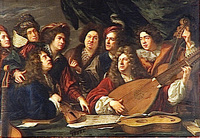- concept
- Viola (greek)
- English
-
-
The viol (/ˈvaɪəl/),[1] viola da gamba[a] (Italian: [ˈvjɔːla da (ɡ)ˈɡamba]), or informally gamba, is any one of a family of bowed, fretted and stringed instruments with hollow wooden bodies and pegboxes where the tension on the strings can be increased or decreased to adjust the pitch of each of the strings. Frets on the viol are usually made of gut, tied on the fingerboard around the instrument's neck, to enable the performer to stop the strings more cleanly. Frets improve consistency of intonation and lend the stopped notes a tone that better matches the open strings. Viols first appeared in Spain in the mid to late 15th century and were most popular in the Renaissance[2] and Baroque (1600–1750) periods.[3] Early ancestors include the Arabic rebab and the medieval European vielle,[4][5] but later, more direct possible ancestors include the Venetian viole[6] and the 15th- and 16th-century Spanish vihuela, a 6-course plucked instrument tuned like a lute (and also like a present-day viol)[4][5] that looked like but was quite distinct from (at that time) the 4-course guitar[7] (an earlier chordophone).[8]
⟶ wikipedia
-
-
- Q40125 ⟶ Click Here
- Hornbostel–Sachs classification: 321.322-71 (Composite chordophone sounded by a bow)
Viol
Viol
Βιολί (greek) | Viole de gambe (French)
Works belonging to this subject category




